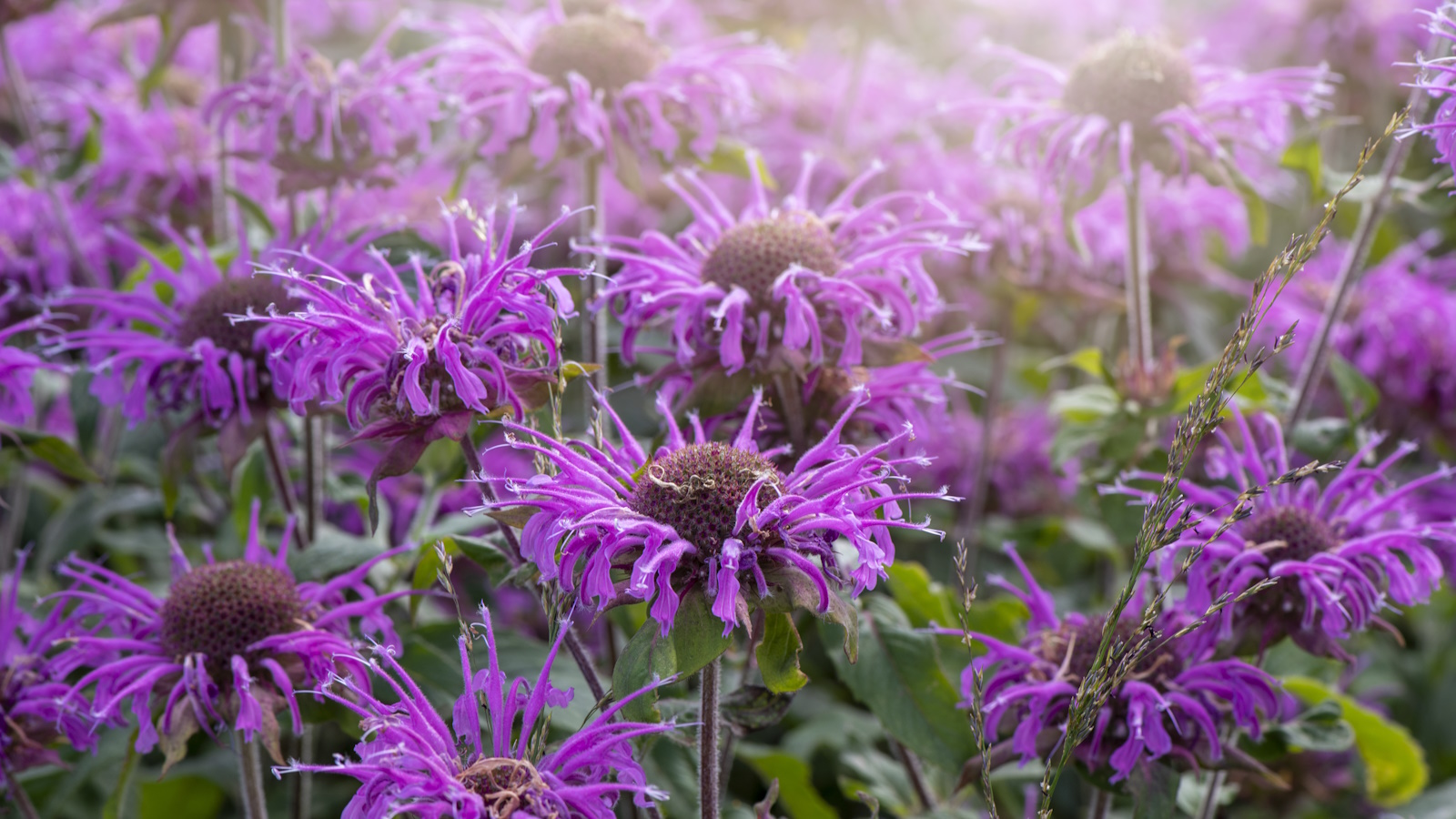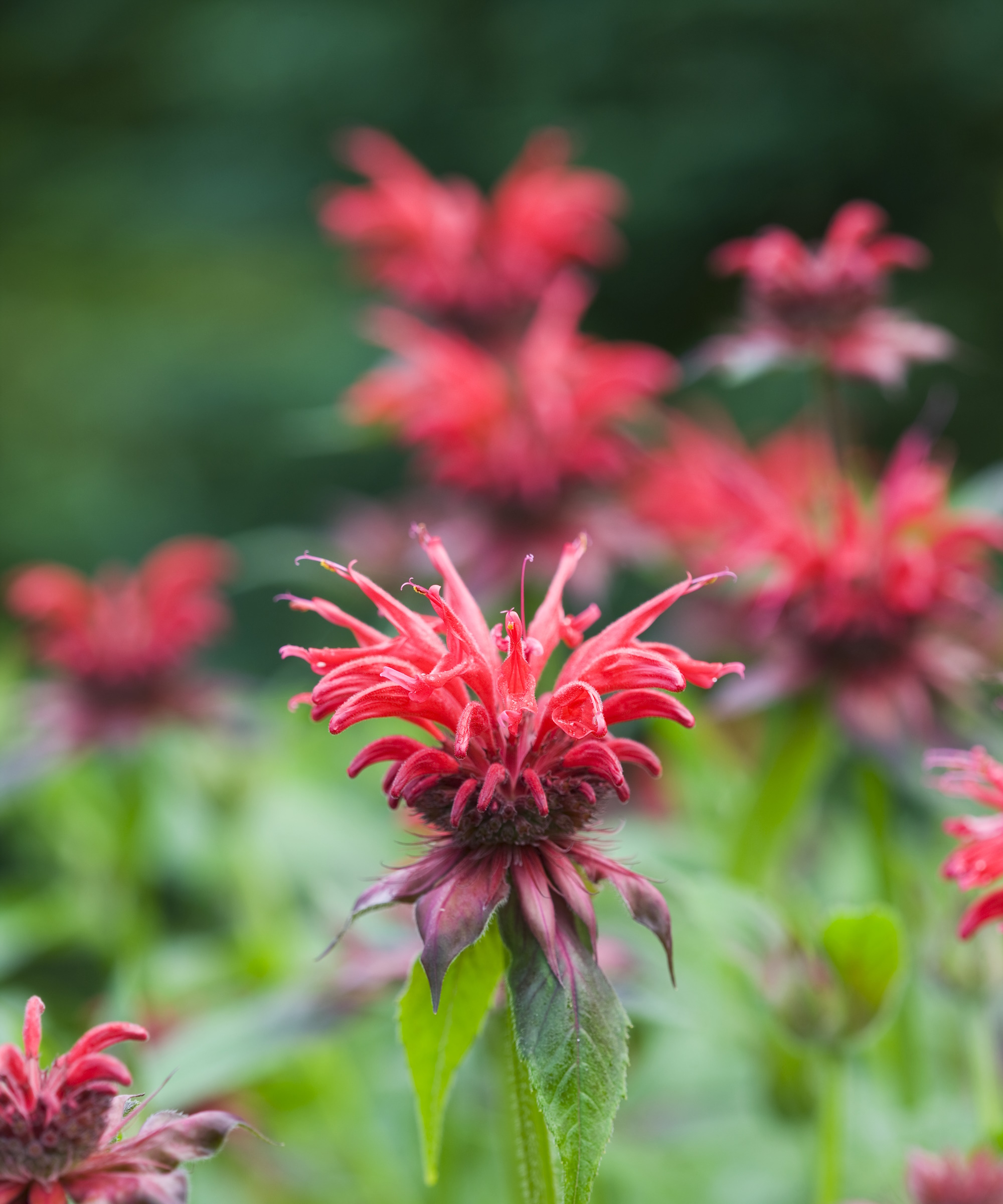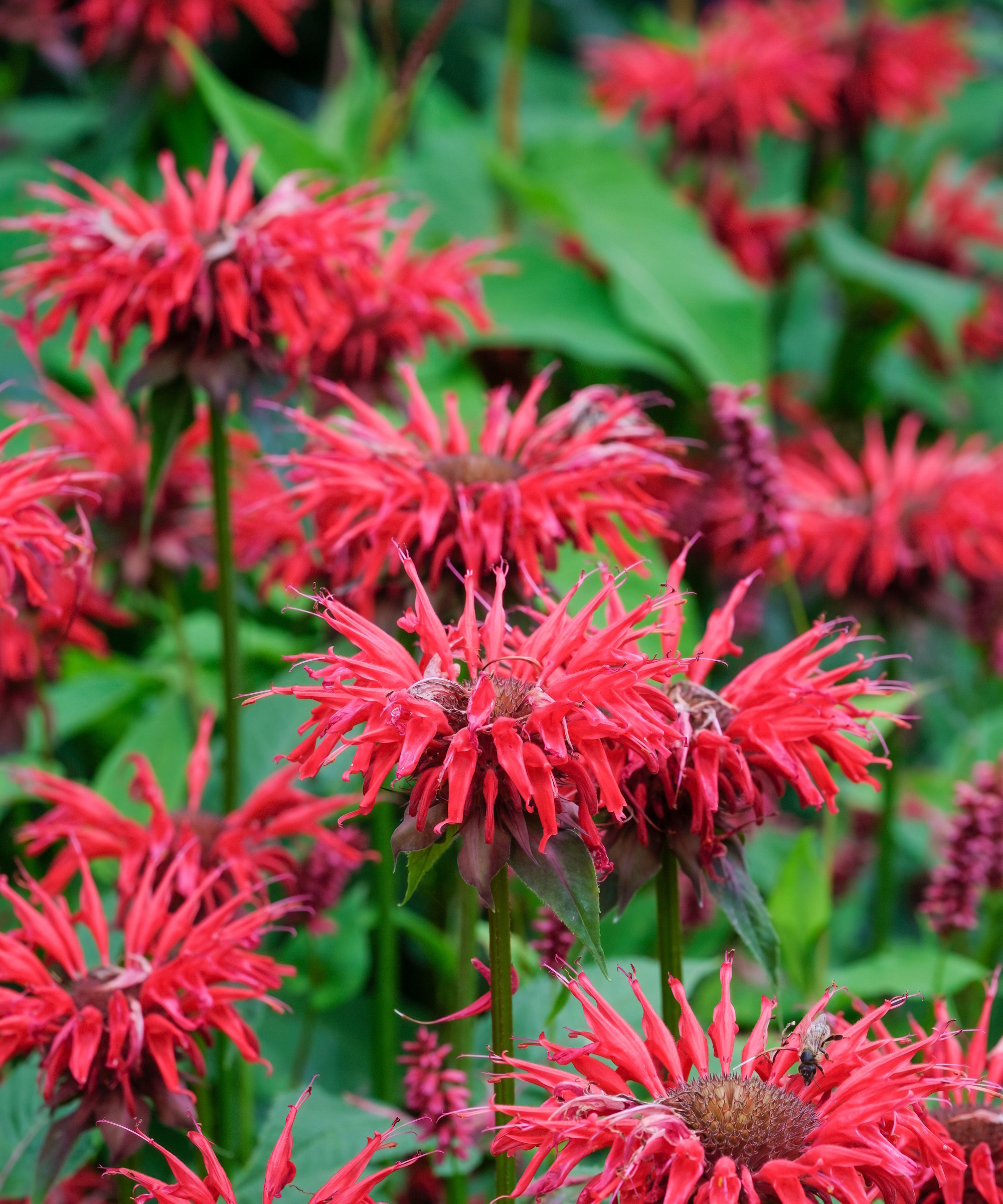Best monarda varieties – 10 types of pollinator-friendly beebalm
This perennial is a butterfly magnet, adding fragrance and biodiversity to your yard


- Balmy beebalm (Monarda Balmy Series)
- Lemon beebalm (Monarda citriodora)
- Scarlet beebalm (Monarda didyma)
- Wild bergamot (Monarda fistulosa)
- ‘Gardenview Scarlet’ beebalm (Monarda ‘Gardenview Scarlet’)
- Leading Lady beebalm (Monarda Leading Lady Series)
- ‘Panorama’ beebalm (Monarda ‘Panorama’)
- Pardon My bee (Monarda Pardon My Series)
- Spotted Horsemint (Monarda punctata)
- ‘Raspberry Wine’ beebalm (Monarda ‘Raspberry Wine’)
In the best gardens, plants do more than simply look pretty. Of course, their flowers and foliage have to look attractive, but the best varieties have other features to enjoy and appreciate.
In the case of Monarda, commonly known as beebalm or bergamot, the midsummer flowers are certainly colorful. As one of the best plants for pollinators, they provide an important source of nectar and pollen for bees and other insects, as well as hummingbirds. The leaves are powerfully aromatic, as you’ll notice whenever you touch the foliage, and they also make a refreshing minty tea. The powerful aroma from the whole plant usually prevents browsing by deer and rabbits.
These are mostly summer flowering, sun-loving, hardy perennial plants reaching 2-4ft, although shorter varieties are now being developed. The slender arching flowers are gathered in clusters at the tips of the square shoots, and in tiers lower down. The small leaves, immediately below the flower clusters are often tinted in purple or red – adding another attractive feature. Below, we have gathered 10 of the best varieties to consider adding to your planting schemes.

10 of the best monarda varieties for your yard
All monardas are North American native plants that are found in every state and much of Canada, although they’re less often seen growing wild in the west. They belong to the mint family, and are hardy across most of the country.
The creeping stems spread strongly but are shallow-rooted, so can easily be removed if necessary. The main problem is mildew which can turn whole plants grey in dry seasons, but usually seems to do no lasting damage. Keeping the roots damp in summer is a good preventative.
Mildew-resistant varieties are now becoming available along with varieties that stay much more compact, less than half the height of traditional types – so the choice is widening every year.
A good range of monardas is available from Burpee.
Design expertise in your inbox – from inspiring decorating ideas and beautiful celebrity homes to practical gardening advice and shopping round-ups.
Balmy beebalm (Monarda Balmy Series)

An unusually neat and compact series of beebalms in four colors – lilac, such as this one from Burpee, pink, rose, and purple, such as this one from Nature Hills.
The rose and purple types also feature unusually dark leaves. All varieties in the 'Balmy Series' show a good resistance to mildew. Plants may not reach their full height until their second year.
Type: Hardy perennial
Good for: The front of sunny borders, along paths, in large containers, attracting pollinators. Avoid very dry situations.
Height: 12-18in
Care: Plant in spring. Ensure the roots are moist in summer, cut back hard after flowering, then lift, divide and replant every two or three years.
Hardiness: USDA zone 4
Lemon beebalm (Monarda citriodora)

This short-lived species, often grown as an annual, is native to southern states and is easily distinguished by its lemon-scented leaves that make a refreshing tea. Each stem usually carries two clusters of white or blushed summer flowers that are prettily speckled in purple.
Type: Hardy perennial, biennial or annual.
Good for: Refreshing tea, attracting pollinators, restoration plantings.
Height: 20-28in
Care: Deadhead promptly to encourage longevity, or grow as an annual and allow seed to be shed and sprout for a new display. Irrigate in summer to prolong flowering and deter mildew.
Hardiness: USDA zone 5
Scarlet beebalm (Monarda didyma)

The classic, wild red beebalm from which so many improved garden varieties have been developed. Its brilliant coloring instantly appeals, along with the bergamot fragrance of the foliage.
The most widely grown species, 'scarlet beebalms, has foliage that smells of Earl Gray tea. It was found by European settlers near Oswego, NY so is still sometimes known as the Oswego tea plant. Most named varieties are derived, at least in part, from this species.
Type: Hardy perennial
Good for: Sunny perennial borders, attracting pollinators, restoration plantings.
Height: 30-40in
Care: Best in cool summers and in soils that do not dry out. Cut back hard after flowering. Lift, divide and replant every in spring every two or three years.
Hardiness: USDA zone 5
Wild bergamot (Monarda fistulosa)
Strong growing, making prolific clumps of upright stems carrying strongly aromatic foliage, and topped with two or three clusters of pale lilac flowers.
Native to almost the whole country, and popular with a wide range of insects. This widespread wild species is very pretty. While the variety ‘Humdinger’, available from Burpee, has more richly colored, purple-pink flowers.
Type: Hardy perennial
Good for: Sunny perennial borders, prairies and meadows, restoration plantings.
Height: 2-4ft
Care: Best in cool summers and in soils that do not dry out. Lift, divide and replant every in spring every two or three years but seedlings usually sprout nearby. Often troubled by mildew but plants usually recover.
Hardiness: USDA zone 5
‘Gardenview Scarlet’ beebalm (Monarda ‘Gardenview Scarlet’)

One of the most popular and prolific beebalms for its natural vigor, vivid scarlet flower coloring, resistance to mildew and the purplish tints to the late leaves that color after flowering. It was developed at Gardenview Park, in Ohio, and is a favorite with butterflies, hummingbirds and other pollinators.
‘Gardenview Scarlet’ beebalm plants are available at Walmart.
Type: Hardy perennial
Good for: Perennial borders, mixed borders, cutting.
Height: 3ft
Care: Plant in spring. Best in full sun and in soils that do not dry out. Cut back to the ground when the last flowers are over to stimulate fresh growth. Lift, divide and replant every in spring every two or three years.
Hardiness: USDA zone 4
Leading Lady beebalm (Monarda Leading Lady Series)
Six recently introduced, very short and bushy varieties that remain tightly clump forming and don’t become a nuisance by spreading.
They come in amethyst, lilac, orchid, pink, plum, such as this one available from Burpee, and raspberry with the lower lip of most prettily spotted in the throat. They also come into flower earlier than other monardas.
Type: Hardy perennial.
Good for: The front of sunny borders, containers.
Height: 10-14in, a little taller in their second year.
Care: Plant in spring, in full sun in rich well drained soil. Irrigate to keep the plants moist in summer.
Hardiness: USDA Zone 4
Lilac 'leading lady' beebalm is also available from Burpee.
‘Panorama’ beebalm (Monarda ‘Panorama’)

‘Panorama’ is different from other monardas as it is usually supplied only as packets of seed. Plants flower in the first year from an early spring seed starting, or on large plants the following summer. The flowers come in a good range of colors including red, pink, salmon, purple and white and some in between shades. This is a very economical way to start with monardas.
Type: Hardy perennial, grown from seeds.
Good for: Mass plantings, cut flowers.
Height: 3ft
Care: Sow seeds in a bright, frost free place in late winter, move the seedlings into individual pots and grow on for planting after the last frost in your area. Plant out 12-8in apart in rich soil in full sun. Deadhead and cut the plants down in fall.
Hardiness: USDA zone 4
Pardon My bee (Monarda Pardon My Series)

Four dwarf, bushy varieties with a valuable resistance to powdery mildew and so ideal in areas with dry summers where mildew is often problem. In spite of their short growth and compact growth, the cerise, lavender, purple or rose flower heads are the same size as those of taller varieties. A little taller, and a little more vigorous than the Leading Lady Series, but still good for small spaces.
Type: Hardy perennial
Good for: The front of sunny borders, containers.
Height: 14-18in, a little taller in their second year.
Care: Plant in spring, in full sun in rich well drained soil. Irrigate to keep the plants moist in summer.
Hardiness: USDA zone 4.
Spotted Horsemint (Monarda punctata)

This underrated plant features two or three tiers of small, crowded speckled flowers settled on a ring of pointed leaves in pale lavender pink and all above unusually dark green leaves. Very pretty and intriguing, spreads less than other varieties and shows some resistance to mildew.
Type: Hardy perennial or biennial.
Good for: Informal borders, prairies and restorations.
Height: 30-40in
Care: Happier in dry conditions than other monardas and tolerates a little shade.
Hardiness: USDA zone 4
‘Raspberry Wine’ beebalm (Monarda ‘Raspberry Wine’)

The raspberry red coloring marks out this prolific variety, richer in color than many varieties whose flowers are mostly scarlet. Its unusually long flowering period is also a feature plus its dark foliage that sets off the flowers well.
Type: Hardy perennial
Good for: Perennial borders, mixed borders, cutting.
Height: 30-36in
Care: Best planted in spring in rich, but well drained soils and divided every two or three years for the most impressive display.
Hardiness: USDA zone 4
Planting with pollinators in mind has never been more important, or more on trend when it comes to our gardens - even container gardening trends. Beebalm is an ideal plant to grow in a container, as this limits its potential to spread in the garden. It's tall stems and brightly colored blooms would make for a striking centerpiece as part of a summer patio or deck display.

Graham Rice is a garden writer who has won awards for his work online, and in books and magazines, on both sides of the Atlantic. He is a member of a number of Royal Horticultural Society committees and the recipient of the 2021 Garden Media Guild Lifetime Achievement Award. He gardened in Pennsylvania for 20 years, but has recently returned to his native England.